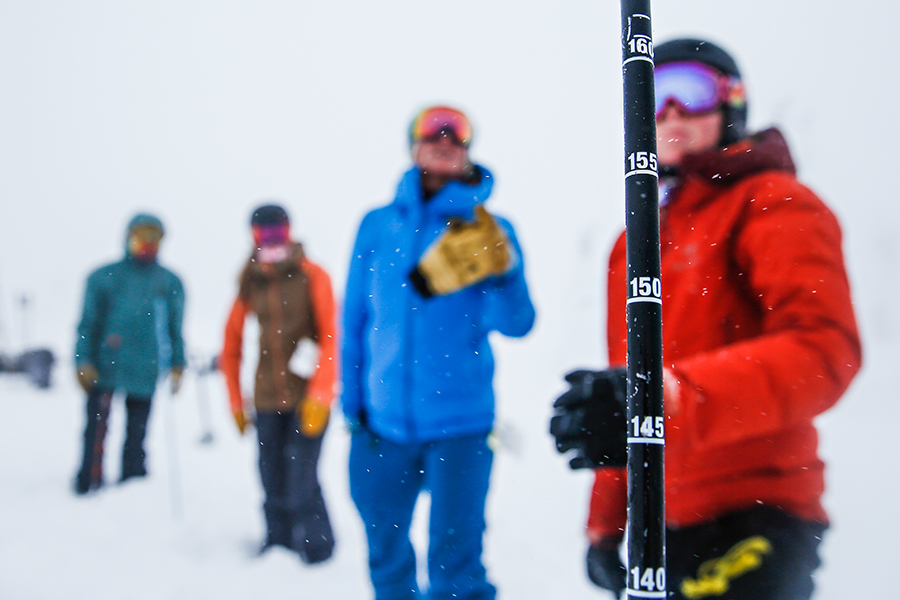Avalanche Forecasters Expect Busy Backcountry Season
Flathead Avalanche Center officials emphasize importance of communication, safety and training in a potentially more crowded backcountry
By Maggie Dresser
When the ski lifts quit spinning early last March and the pandemic closed ski areas nationwide, Whitefish Mountain Resort (WMR) began to see an influx of skiers and splitboarders skinning uphill, backcountry trailheads saw packed parking lots and gear shops sold out of nearly all of their touring gear.
With a widespread perception that the backcountry will be more crowded this winter, there’s been concern that new and inexperienced users will bring additional avalanche hazards to the mountains. But Flathead Avalanche Director Blase Reardon says that might not necessarily be true.
“I think there’s this idea that there will be more people in the backcountry and there will be all these newbies and they’re going to get into trouble,” Reardon said. “I think that’s an easy story to tell but I don’t think it’s supported by what we already know. I am expecting things to be unusual, but I’m not sure how they will be unusual.”
In a study compiled by the Colorado Avalanche Information Center (CAIC), avalanche professionals found that backcountry travel spiked after ski resorts closed on March 14. For the 2019-2020 season, the CAIC recorded 16 people involved in 11 avalanches from November to mid-February. From mid-March to the end of April, there were 10 people involved in 9 avalanches.
The report also found that 40% of the people caught in an avalanche had taken a Level 1 avalanche course and 70% had intermediate or advanced experience.
While Reardon says there are some limitations since there’s only data available from one season, he agrees that people who are caught in avalanches typically have some education rather than no education.
“The lesson for this is people are using their training to travel more and further into avalanche terrain during more dangerous conditions,” Reardon said.
Between overconfidence and miscalculations, it’s more likely for these user groups to get into trouble in the backcountry. Reardon says the perception of overcrowding in the mountains might also push people to unfamiliar, exposed and dangerous terrain.
Anecdotally, Flathead Avalanche Center forecasters noticed that trailheads seemed busier when the resorts closed last season, but Reardon says not all recreationists were necessarily going into the backcountry. Many might have been cross-country skiing or snowshoeing close to the trailhead. WMR had the most obvious increased traffic last spring, Reardon said, which was concerning because many might not have realized when they were in avalanche terrain.
“There were a lot of folks up there (who were) not recognizing when they were in avalanche terrain,” Reardon said. “That terrain is no longer mitigated and there was some real backcountry danger requiring a full set of avalanche gear.”
At Rocky Mountain Outfitter in Kalispell, owner Jandy Cox says alpine touring gear sales are roughly twice of what they normally are this time of year. While he’s also selling more avalanche gear than normal, he says many of his customers are buying gear simply to skin up Big Mountain and some don’t necessarily have plans to head into the backcountry.
“Alpine touring gear sales have been unprecedented,” Cox said.
When WMR shut down last spring, Cox saw a spike in business, and even though his shop closed due to the shutdown, he sold out of almost every pair of skies and skins over the phone.
And while there appears to be more interest in backcountry activities since the pandemic hit, Reardon says there’s also an uptick in avalanche training interest and the Avalanche Center is receiving significantly more phone calls and emails. Reardon has heard reports that Colorado Mountain School has three times as many people registered for classes.
Friends of the Flathead Avalanche Center (FOFAC) is offering the same number of classes as in years past but also offering a variety of specific topics like gear, behavior and refresher classes.
With an unusual ski season ahead, Reardon says backcountry basics are now more important than ever.
“Get the training, get the forecast, get the gear and practice with your equipment,” Reardon said. “It’s a good time to make sure that everybody that you regularly ride with has their rescue skills practiced and up to date.”
This year, it will also be especially important to have good communication with other parties in the backcountry to ensure groups aren’t skiing on top of each other, a potential hazard that can lead to avalanche triggers on unbeknownst parties.
“One potential effect of the season is there’s going to be more people at the trailhead and in the places that people like to go,” Reardon said. “Our natural instinct is to keep to ourselves. Part of the reason people are out there is for solitude.”
Reardon also stresses the importance of keeping smaller groups in the backcountry, ideally with two to four, since larger groups are harder to manage.
“We’re all going to have to be friendlier and start working together,” Reardon said. “Check the forecast every day and don’t let your training lure you into more exposure.”
Flathead Avalanche Center daily forecasts begin Dec. 9 and run through early April.
For more information, visit www.flatheadavalanche.org.